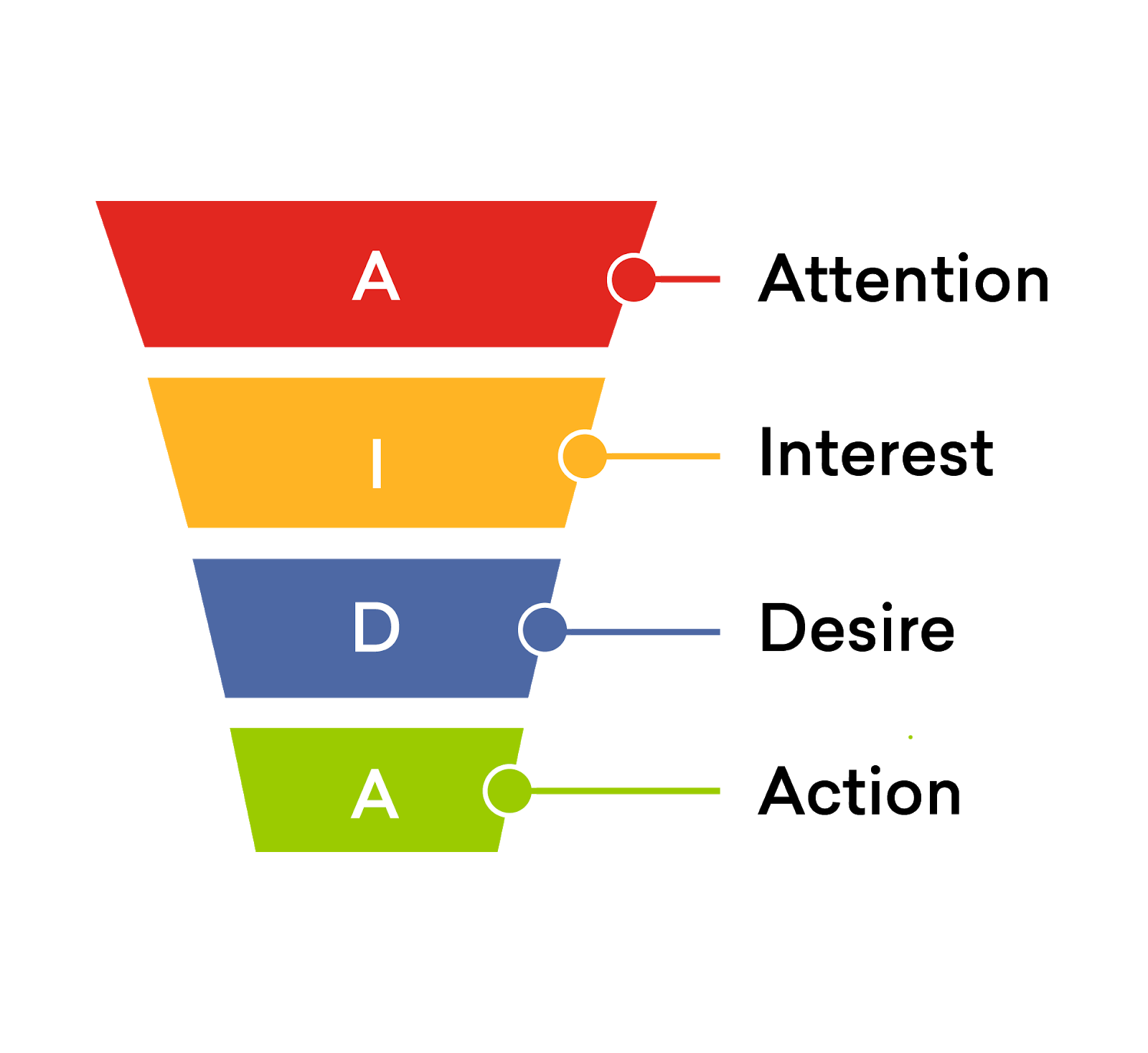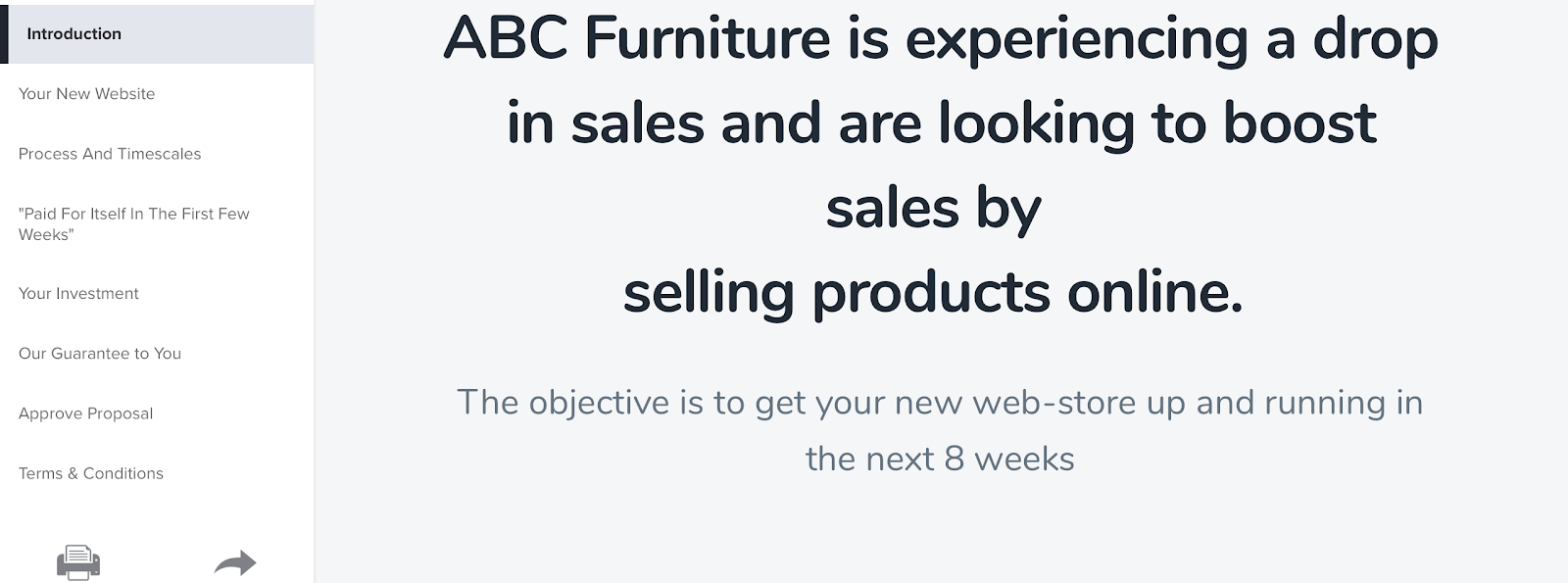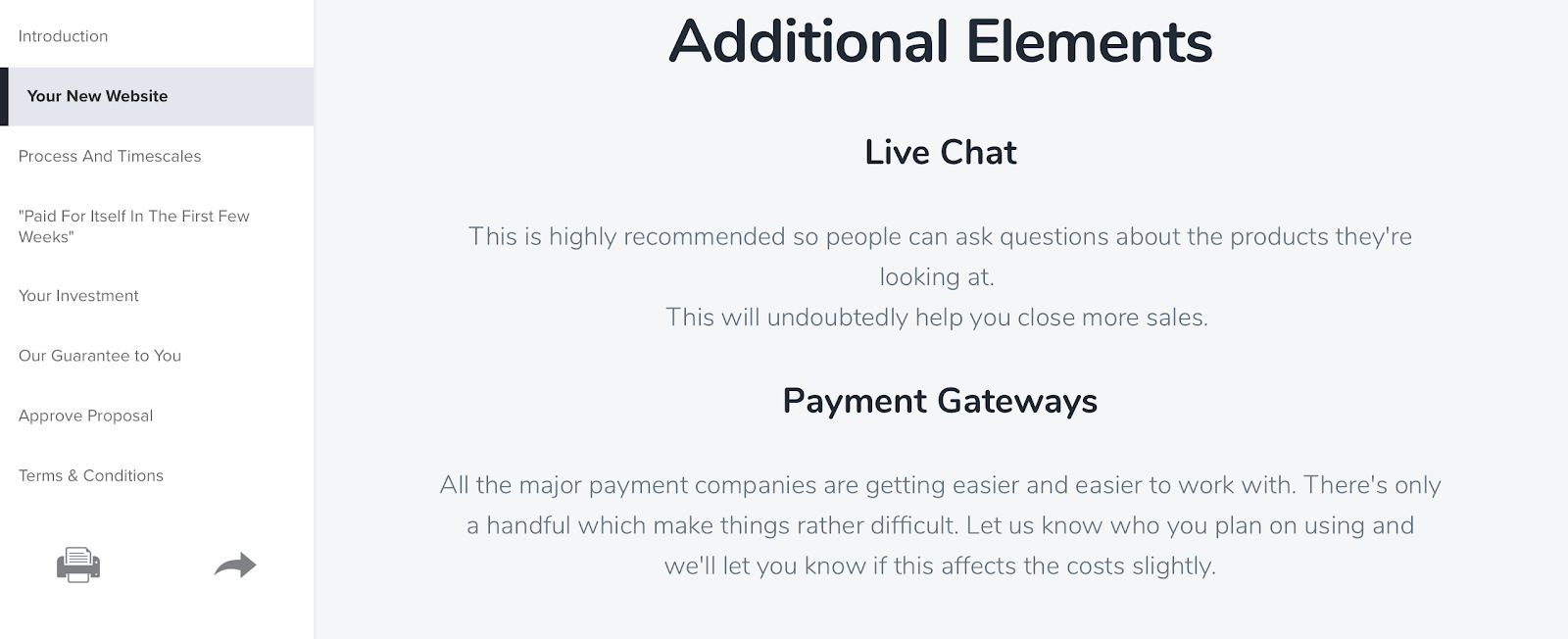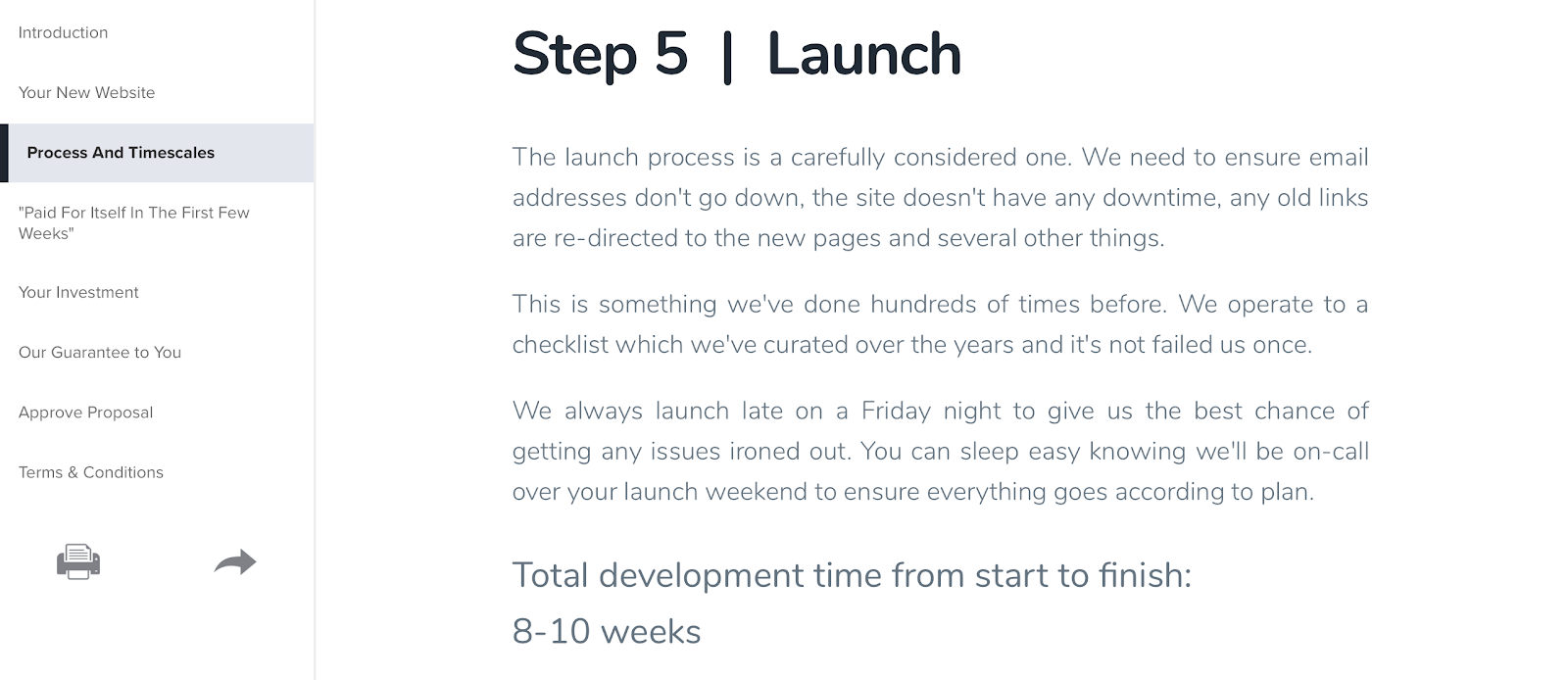Most people dread writing a proposal. This is understandable. After all, it’s a labor-intensive process, with no guarantee of success. In fact, it’s the sales method that takes the longest with the least guarantee of success. But don’t stop reading just yet.
The flip side of this is that sales proposals are basically non-optional for gaining high-paying clients.
If you want to join the big leagues, you’re going to have to get good at writing sales proposals, fast! Lucky for you, it really isn’t rocket science. With a little bit of knowledge, anybody can write a sales proposal and structure it mindfully to achieve the best closing rate.
Today, we’ll look at the basics of how to write a sales proposal. Before that, let’s take a quick look at what exactly a sales proposal is.
What is a sales proposal?
In simple terms, a sales proposal is a document that an organization or sales professionals use to pitch their services and products to potential customers.
This crucial document showcases value propositions for future customers and can be the turning point in converting a prospect into a customer.
Sales proposals are mostly used by consultants, agencies, sales teams, and freelancers to show their prospects what they can offer if they choose to go ahead and do business with them.
Let’s take a look at how you can write an effective sales proposal. There are three main steps.
Step 1: Identifying the client’s core business problem
The thing to recognize is that most clients are only interested in one thing — money. They’re usually less interested in the nitty-gritty details of your product or service. Naturally, you should focus on how to make your clients more money or how to stop them from losing it.
This involves identifying a solvable business problem.
Some common examples include:
In any case, your goal then becomes solving this problem. However, these are all generic business problems. Businesses can solve them in lots of different ways.
In the proposal stage, the challenge is convincing the reader they should pay you to solve their problem.
The next task is to link their problem to your specific solution.
Throughout your sales proposal, your task is to convince your prospect of the link between what they need and what you offer. We’ll draw this out in more detail a little later. For now, it’s worth thinking about a sales proposal like any other business plan.
This is kind of a psychological hack, with two really important benefits:
- It improves your motivation to put everything you’ve got into every proposal.
- The reader will feel like the project is already underway, so it’s less of a leap to sign on the dotted line.
Now that we’ve got the theory out of the way let’s start looking at how to put our proposal together.
Step 2: Structuring your a sales proposal
It’s helpful to think of sales proposals as a microcosm of a standard sales funnel. Obviously, you’ll rarely send cold proposals, but essentially you’re still trying to bring the reader from the awareness stage to being ready to make a purchase.
Standard sales funnel
 Good sales proposals follow the same structure as a basic sales funnel
Good sales proposals follow the same structure as a basic sales funnel
In other words, you don’t want to scare them off with a bunch of technical details right from the get-go.
Roughly speaking, most proposals include the following elements in their body:
- an attention-grabbing introduction,
- a methodology section,
- practical details, like timelines and deliverables,
- case studies.
This basic format is normally followed by the legal stuff. Modern proposals also integrate a project sign-off to improve their close rate.
Step 3: Creating a sales proposal
Now that we’ve covered the basics of structuring a sales proposal let’s dig into a little more detail of what makes each section tick. More specifically, we’ll cover the role of each section, as well as giving some copywriting tips to optimize them for success.
Create an attention-grabbing introduction
With any project proposal, the first hurdle to overcome is actually getting someone to read the whole thing. And by read, I mean really read, not skim through it and move on with their day.
The key to this is grabbing their attention and making them excited about reading on.
After years of working on proposals, I think there’s one surefire way to achieve this. Even better, you already have exactly the information you need, because you’ve already identified the problem you’re going to solve.
So be bold and state your goal upfront. The more concrete, the better.
Think about it. If you opened a proposal, and the first line was “we’re going to make you an extra $100 million this year,” you’d keep reading. Of course, this works best if you can actually provide an extra $100 million of revenue.
Still, the same principle applies to more modest goals. Look at this example:
 Leading with your goals is the best way to grab the reader’s attention
Leading with your goals is the best way to grab the reader’s attention
Setting your goal early also establishes the fundamentals of a winning sales proposal. It’s a chance to show from the outset that you understand the client’s problems, which makes it easier to convince them you can solve them.
Explain how you’ll solve the problem
This is probably the hardest part of any sales proposal. At least, it’s a difficult balancing act to achieve. That is, you need to convince the reader that your solution will actually work, without boring the pants off them with the technical details.
To a certain extent, this comes with practice. Still, there are plenty of tips and tricks you can pick up to create an effective and engaging methodology section.
For one, I like to make use of headings to group the different parts of the methodology section in a digestible way. This helps readers without a good technical grounding to understand all the different elements of your project and how they relate to each other.
 Use subheadings in your methodology section to improve comprehension
Use subheadings in your methodology section to improve comprehension
It’s also vital to watch your language. Remember, you’re an expert in your field, demonstrate your expertise with authoritative language without being overly technical. You need to recognize that not everyone shares this expertise. The crux of this is that industry jargon will alienate many readers. If there are too many unfamiliar terms in your methodology, many readers will simply stop listening.
For instance, if you run a marketing automation company, you should focus on what you can deliver rather than the process that you use.
The methodology section is also your main vehicle for educating the reader. Specifically, this is the ideal place to convince them there’s a link between their business goals and what you provide.
An easy way to do this is to provide hard facts, in the form of statistics and graphs. When you’re trying to convince someone of a link between two phenomena, you can’t beat a good graph.
Present project timelines
Project timelines are a great way to sneak your value proposition through the back door. That is, this is your chance to show off your wonderful solution in terms of what it will achieve for the client.
Every project timeline communicates two basic pieces of information:
- What the client will receive and when.
- What they’ll need to do to achieve this.
Obviously, you want to focus on what you’re going to deliver and make this seem as pain-free as possible. In an ideal world, their side of the bargain would be something like “sit back and count your money.”
We don’t live in an ideal world, but the rule of thumb is to present your project as giving them as much benefit with as little effort as possible.
 Timelines are a great chance to reinforce your value proposition
Timelines are a great chance to reinforce your value proposition
A robust timescale and deliverables section also projects a great image of your company. In short, it makes you look like a diligent and hardworking player in your field. This helps convince the reader you can solve their problem.
Add proof to your sales proposals
Finally, every good sales proposal includes a case study. A solid proportion of your readers will make it to the end of your proposal without being totally convinced. They can’t argue with results, though.
Remember, your clients only really care about their bottom line. A good way to leverage this fact is to show off a competitor or one of your clients who’s making an extra bundle of cash because of your work. In fact, the more similarities between your customer success story and the reader, the better.
The reason that this is so important comes down to social proof. Throughout your proposal, you’ve talked about how you can solve the reader’s problem, but you’ve done it in a theoretical way.
Case studies allow you to prove your concept. Even the most skeptical reader will sit up and take notice of this.
The bottom line
Writing effective sales proposals can often be a challenge. However, it doesn’t have to be. In fact, once you understand the basics of structuring and writing a winning proposal, success comes pretty naturally.
This starts with getting a sound understanding of what a successful proposal actually does. In short, this is all about identifying a solvable business problem and convincing the reader that your offering is the right one to solve it.
Then, you can follow a set formula, from grabbing the reader’s attention in your introduction, all the way to using effective case studies to win over skeptics. In between, your methodology and deliverables sections educate the reader about the link between your solution and their problems. To learn more about the science of creating sales proposals, you can check out Proposal University by Better Proposals, a comprehensive guide on how to write and design high-converting business agreements.